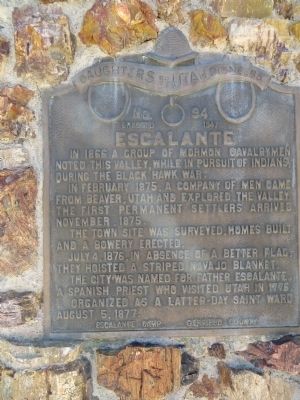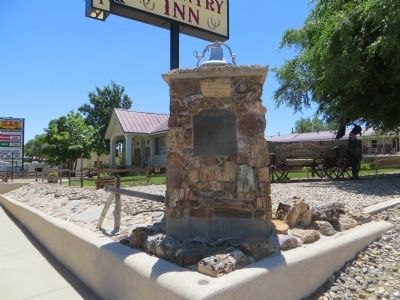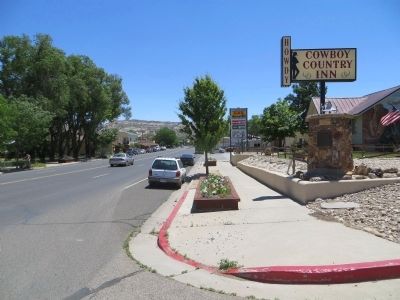Escalante in Garfield County, Utah — The American Mountains (Southwest)
Escalante
In February, 1875, a company of men came from Beaver, Utah and explored the valley. The first permanent settlers came from Beaver, Utah and explored the valley. The first permanent settlers arrived November, 1875.
The townsite was surveyed, homes built and a bowery erected.
July 4, 1876, in absence of a better flag, they hoisted a striped Navajo blanket.
The city was named for Father Escalante, a Spanish priest who visited Utah in 1776.
Organized as a Latter-Day Saint Ward Aug. 5, 1877.
Erected 1947 by Escalante Camp, Daughters of Utah Pioneers. (Marker Number 94.)
Topics and series. This historical marker is listed in this topic list: Settlements & Settlers. In addition, it is included in the Daughters of Utah Pioneers series list. A significant historical month for this entry is February 1875.
Location. 37° 46.213′ N, 111° 36.126′ W. Marker is in Escalante, Utah, in Garfield County. Marker is at the intersection of West Main Street and South 100 W, on the right when traveling east on West Main Street. Marker is on the southeast corner. Touch for map. Marker is in this post office area: Escalante UT 84726, United States of America. Touch for directions.
Other nearby markers. At least 8 other markers are within 9 miles of this marker , measured as the crow flies. L.D.S. Tithing Office (about 500 feet away, measured in a direct line); Old White Church (about 600 feet away); First Public Building (about 800 feet away); Old Boulder Mail Trail (approx. 1.1 miles away); Granary in the Cliffs (approx. 6.8 miles away); View from Head of the Rocks (approx. 8.3 miles away); Building the Million-dollar Road (approx. 8.3 miles away); Conserving Wildness (approx. 8.3 miles away). Touch for a list and map of all markers in Escalante.
Credits. This page was last revised on June 16, 2016. It was originally submitted on June 23, 2014, by Bill Kirchner of Tucson, Arizona. This page has been viewed 515 times since then and 25 times this year. Photos: 1, 2, 3. submitted on June 23, 2014, by Bill Kirchner of Tucson, Arizona. • Syd Whittle was the editor who published this page.


